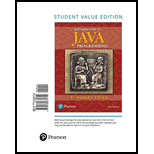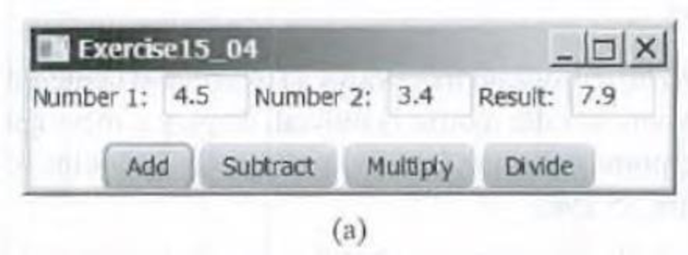
Introduction to Java Programming and Data Structures: Brief Version (11th Global Edition)
11th Edition
ISBN: 9780134671710
Author: Y. Daniel Liang
Publisher: PEARSON
expand_more
expand_more
format_list_bulleted
Concept explainers
Textbook Question
Chapter 15, Problem 15.4PE
(Create a simple calculator) Write a

Expert Solution & Answer
Want to see the full answer?
Check out a sample textbook solution
Students have asked these similar questions
using r language for integration theta = integral 0 to infinity (x^4)*e^(-x^2)/2 dx (1) use the density function of standard normal distribution N(0,1) f(x) = 1/sqrt(2pi) * e^(-x^2)/2 -infinity <x<infinity as importance function and obtain an estimate theta 1 for theta set m=100 for the estimate whatt is the estimate theta 1? (2)use the density function of gamma (r=5 λ=1/2)distribution f(x)=λ^r/Γ(r) x^(r-1)e^(-λx) x>=0 as importance function and obtain an estimate theta 2 for theta set m=1000 fir the estimate what is the estimate theta2? (3) use simulation (repeat 1000 times) to estimate the variance of the estimates theta1 and theta 2 which one has smaller variance?
using r language A continuous random variable X has density function f(x)=1/56(3x^2+4x^3+5x^4).0<=x<=2 (1) secify the density g of the random variable Y you find for the acceptance rejection method. (2) what is the value of c you choose to use for the acceptance rejection method (3) use the acceptance rejection method to generate a random sample of size 1000 from the distribution of X .graph the density histogram of the sample and compare it with the density function f(x)
using r language a continuous random variable X has density function f(x)=1/4x^3e^-(pi/2)^4,x>=0
derive the probability inverse transformation F^(-1)x where F(x) is the cdf of the random variable X
Chapter 15 Solutions
Introduction to Java Programming and Data Structures: Brief Version (11th Global Edition)
Ch. 15.2 - Prob. 15.2.1CPCh. 15.2 - Prob. 15.2.2CPCh. 15.3 - Why must a handler be an instance of an...Ch. 15.3 - Explain how to register a handler object and how...Ch. 15.3 - Prob. 15.3.3CPCh. 15.3 - What is the registration method for a button to...Ch. 15.4 - Can an inner class be used in a class other than...Ch. 15.4 - Can the modifiers public, protected, private, and...Ch. 15.5 - Prob. 15.5.1CPCh. 15.5 - What is wrong in the following code?
Ch. 15.6 - Prob. 15.6.1CPCh. 15.6 - What is a functional interface? Why is a...Ch. 15.6 - Prob. 15.6.3CPCh. 15.8 - Prob. 15.8.1CPCh. 15.8 - Prob. 15.8.2CPCh. 15.9 - Prob. 15.9.1CPCh. 15.9 - Prob. 15.9.2CPCh. 15.9 - Prob. 15.9.3CPCh. 15.9 - If the following code is inserted in line 57 in...Ch. 15.10 - Prob. 15.10.1CPCh. 15.11 - Prob. 15.11.1CPCh. 15.11 - Prob. 15.11.2CPCh. 15.11 - Prob. 15.11.3CPCh. 15.11 - Prob. 15.11.4CPCh. 15.12 - How does the program make the ball appear to be...Ch. 15.12 - How does the code in Listing 15.17, BallPane.java,...Ch. 15.12 - What does the program do when the mouse is pressed...Ch. 15.12 - If line 32 in Listing 15.18, BounceBall.java, is...Ch. 15.12 - Prob. 15.12.5CPCh. 15.13 - Prob. 15.13.1CPCh. 15.13 - What would happen if map is replaced by scene in...Ch. 15.13 - Prob. 15.13.3CPCh. 15 - Prob. 15.1PECh. 15 - (Rotate a rectangle) Write a program that rotates...Ch. 15 - (Move the ball) Write a program that moves the...Ch. 15 - (Create a simple calculator) Write a program to...Ch. 15 - (Create an investment-value calculator) Write a...Ch. 15 - (Alternate two messages) Write a program to...Ch. 15 - (Change color using a mouse) Write a program that...Ch. 15 - (Display the mouse position) Write two programs,...Ch. 15 - (Draw lines using the arrow keys) Write a program...Ch. 15 - (Enter and display a string) Write a program that...Ch. 15 - (Move a circle using keys) Write a program that...Ch. 15 - Prob. 15.12PECh. 15 - (Geometry: inside a rectangle?) Write a program...Ch. 15 - Prob. 15.14PECh. 15 - Prob. 15.15PECh. 15 - (Two movable vertices and their distances) Write a...Ch. 15 - (Geometry: find the bounding rectangle) Write a...Ch. 15 - Prob. 15.18PECh. 15 - (Game: eyehand coordination) Write a program that...Ch. 15 - Prob. 15.20PECh. 15 - (Drag points) Draw a circle with three random...Ch. 15 - (Auto resize cylinder) Rewrite Programming...Ch. 15 - Prob. 15.23PECh. 15 - Prob. 15.24PECh. 15 - Prob. 15.25PECh. 15 - Prob. 15.26PECh. 15 - Prob. 15.27PECh. 15 - (Display a running fan) Write a program that...Ch. 15 - (Racing car) Write a program that simulates car...Ch. 15 - Prob. 15.30PECh. 15 - Prob. 15.31PECh. 15 - (Control a clock) Modify Listing 14.21,...Ch. 15 - (Game: bean-machine animation) Write a program...Ch. 15 - Prob. 15.34PECh. 15 - Prob. 15.35PECh. 15 - Prob. 15.36PE
Knowledge Booster
Learn more about
Need a deep-dive on the concept behind this application? Look no further. Learn more about this topic, computer-science and related others by exploring similar questions and additional content below.Similar questions
- using r language in an accelerated failure test, components are operated under extreme conditions so that a substantial number will fail in a rather short time. in such a test involving two types of microships 600 chips manufactured by an existing process were tested and 125 of them failed then 800 chips manufactured by a new process were tested and 130 of them failed what is the 90%confidence interval for the difference between the proportions of failure for chips manufactured by two processes? using r languagearrow_forwardI want a picture of the tools and the pictures used Cisco Packet Tracer Smart Home Automation:o Connect a temperature sensor and a fan to a home gateway.o Configure the home gateway so that the fan is activated when the temperature exceedsa set threshold (e.g., 30°C).2. WiFi Network Configuration:o Set up a wireless LAN with a unique SSID.o Enable WPA2 encryption to secure the WiFi network.o Implement MAC address filtering to allow only specific clients to connect.3. WLC Configuration:o Deploy at least two wireless access points connected to a Wireless LAN Controller(WLC).o Configure the WLC to manage the APs, broadcast the configured SSID, and applyconsistent security settings across all APs.arrow_forwardA. What will be printed executing the code above?B. What is the simplest way to set a variable of the class Full_Date to January 26 2020?C. Are there any empty constructors in this class Full_Date?a. If there is(are) in which code line(s)?b. If there is not, how would an empty constructor be? (create the code lines for it)D. Can the command std::cout << d1.m << std::endl; be included after line 28 withoutcausing an error?a. If it can, what will be printed?b. If it cannot, how could this command be fixed?arrow_forward
- Cisco Packet Tracer Smart Home Automation:o Connect a temperature sensor and a fan to a home gateway.o Configure the home gateway so that the fan is activated when the temperature exceedsa set threshold (e.g., 30°C).2. WiFi Network Configuration:o Set up a wireless LAN with a unique SSID.o Enable WPA2 encryption to secure the WiFi network.o Implement MAC address filtering to allow only specific clients to connect.3. WLC Configuration:o Deploy at least two wireless access points connected to a Wireless LAN Controller(WLC).o Configure the WLC to manage the APs, broadcast the configured SSID, and applyconsistent security settings across all APs.arrow_forwardTransform the TM below that accepts words over the alphabet Σ= {a, b} with an even number of a's and b's in order that the output tape head is positioned over the first letter of the input, if the word is accepted, and all letters a should be replaced by the letter x. For example, for the input aabbaa the tape and head at the end should be: [x]xbbxx z/z,R b/b,R F ① a/a,R b/b,R a/a, R a/a,R b/b.R K a/a,R L b/b,Rarrow_forwardGiven the C++ code below, create a TM that performs the same operation, i.e., given an input over the alphabet Σ= {a, b} it prints the number of letters b in binary. 1 #include 2 #include 3 4- int main() { std::cout > str; for (char c : str) { if (c == 'b') count++; 5 std::string str; 6 int count = 0; 7 char buffer [1000]; 8 9 10 11- 12 13 14 } 15 16- 17 18 19 } 20 21 22} std::string binary while (count > 0) { binary = std::to_string(count % 2) + binary; count /= 2; std::cout << binary << std::endl; return 0;arrow_forward
- Considering the CFG described below, answer the following questions. Σ = {a, b} • NT = {S} Productions: P1 S⇒aSa P2 P3 SbSb S⇒ a P4 S⇒ b A. List one sequence of productions that can accept the word abaaaba; B. Give three 5-letter words that can be accepted by this CFG; C. Create a Pushdown automaton capable of accepting the language accepted by this CFG.arrow_forwardGiven the FSA below, answer the following questions. b 1 3 a a b b с 2 A. Write a RegEx that is equivalent to this FSA as it is; B. Write a RegEx that is equivalent to this FSA removing the states and edges corresponding to the letter c. Note: To both items feel free to use any method you want, including analyzing which words are accepted by the FSA, to generate your RegEx.arrow_forward3) Finite State Automata Given the FSA below, answer the following questions. a b a b 0 1 2 b b 3 A. Give three 4-letter words that can be accepted by this FSA; B. Give three 4-letter words that cannot be accepted by this FSA; C. How could you describe the words accepted by this FSA? D. Is this FSA deterministic or non-deterministic?arrow_forward
- Considering the TM below, answer the following questions. a/x,R €/E,L €/E,R €/E,L x/E,R c/c,R b/E.L c/c,L x/x,R I J K L M F b/E.L D A. Give three 4-letter words that can be accepted by this TM; B. Give three 4-letter words that cannot be accepted by this TM; C. How could you describe the words accepted by this TM? D. What is the alphabet of the language accepted by this TM?arrow_forwardWhat is the generator? Explain motor generator motorarrow_forwardThis battle room is focused on entry level tasks for a network analyst where you will be given trials and reconnaissance, sensor tuning, log aggregation, SIEM queries, and network analysis. For this week’s project, complete the following tasks: From your Project Ares portal, LOG IN Click on LAUNCH GAME. Select the region NORTH AMERICA Click on Battle School Under the BATTLE SCHOOL pop-up window, click on START TRAINING. Under the BATTLE ROOMS tile, click on ENTER. Under the NETWORK ANALYST tile, click on PLAY. Wait for the Battle Room to load. While loading, the BATTLE ROOM button will display red. Once the Battle Room is loaded, the BATTLE ROOM button will turn yellow and the center of the disk display will indicate CONNECTED. Click on the BATTLE ROOM button to enter the Battle Room. Below the TASKS folder, make sure you click on INSTRUCTIONS to download the Network Analyst Fundamentals material. In the Battle Room, under the TASKS menu select task INTRUSION DETECTION. Complete…arrow_forward
arrow_back_ios
SEE MORE QUESTIONS
arrow_forward_ios
Recommended textbooks for you
 C++ Programming: From Problem Analysis to Program...Computer ScienceISBN:9781337102087Author:D. S. MalikPublisher:Cengage Learning
C++ Programming: From Problem Analysis to Program...Computer ScienceISBN:9781337102087Author:D. S. MalikPublisher:Cengage Learning C++ for Engineers and ScientistsComputer ScienceISBN:9781133187844Author:Bronson, Gary J.Publisher:Course Technology Ptr
C++ for Engineers and ScientistsComputer ScienceISBN:9781133187844Author:Bronson, Gary J.Publisher:Course Technology Ptr Microsoft Visual C#Computer ScienceISBN:9781337102100Author:Joyce, Farrell.Publisher:Cengage Learning,
Microsoft Visual C#Computer ScienceISBN:9781337102100Author:Joyce, Farrell.Publisher:Cengage Learning,

C++ Programming: From Problem Analysis to Program...
Computer Science
ISBN:9781337102087
Author:D. S. Malik
Publisher:Cengage Learning

C++ for Engineers and Scientists
Computer Science
ISBN:9781133187844
Author:Bronson, Gary J.
Publisher:Course Technology Ptr

Microsoft Visual C#
Computer Science
ISBN:9781337102100
Author:Joyce, Farrell.
Publisher:Cengage Learning,
Literals in Java Programming; Author: Sudhakar Atchala;https://www.youtube.com/watch?v=PuEU4S4B7JQ;License: Standard YouTube License, CC-BY
Type of literals in Python | Python Tutorial -6; Author: Lovejot Bhardwaj;https://www.youtube.com/watch?v=bwer3E9hj8Q;License: Standard Youtube License